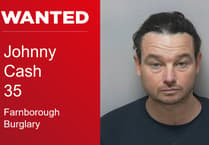A FIRST edition copy of Nicholas Nickleby, signed by its author Charles Dickens, is set to go on show at Alton’s Curtis Museum after it was bought at a car-boot sale for the paltry sum of £1.50.
Making this amazing find was Alton resident Jeremy Bayliss, who discovered what he describes as “a tatty old copy” of the classic while rummaging through books at a boot sale in Bordon some 18 months ago.
An ardent follower of TV programmes like Cash in the Attic and a lover of old books, Mr Bayliss was delighted when he happened upon the leather-bound copy of Nicholas Nickleby.
While he didn’t spot immediately it had been signed by the author, in recent weeks he has taken it to the museum to have it looked at and was referred to local printing expert Luath Grant Ferguson for authentication.
Published in 1839 by Chapman and Hall, inscriptions in the book indicate it has had at least three owners and, while Mr Grant Ferguson feels the condition of this well-read first edition copy would not make it into the priceless artefact it might otherwise be, the signature is “quirky” and does have considerable value.
As the first author to write about people with disabilities, Mr Grant Ferguson believes Dickens may have been the inspiration for William Treloar.
Mr Bayliss has been swept along in a sea of circumstance in his bid to identify the book’s provenance following a chance meeting on a bus with Curtis Museum manager Toby Mearing.
A big Dickens fan, Mr Bayliss learnt that his Bordon car-boot purchase is one of the few first edition copies to survive.
Inside, beneath a “fine engraving” of the author aged 27, can be seen Dickens’ signature, “but with a difference”.
Mr Grant Ferguson said: “Dickens was not only a great writer, he was also a shrewd salesman and performer on stage.
“Hitting on the idea of reading his own works to audiences who paid good money to hear him, he always made sure a good supply of his latest book was on hand, ready to be signed and sold.
“Usually, Dickens had time to write his own short message before signing his name with a magnificent flourish.
“But this copy is different. Dickens seems to have been pushed for time, or else he was trying to sell more copies than usual.
“His regular message, ‘Faithfully yours’, seems to have been written by a different hand in advance, using a different pen nib – a new invention, by the way! – but so low on the page that poor Dickens can just squeeze in a meagre flourish!
“This signature gives a glimpse into the early career of a young author who was definitely going places!”
Mr Mearing has a special reason to be pleased Mr Bayliss has agreed to put the book on display at the museum.
“In 1843, four years after Nicholas Nickleby featured Smike – a youngster disabled by brutal mistreatment – Tiny Tim, a child disabled from birth, stole people’s hearts in A Christmas Carol.
“Also born in 1843 was William Treloar, who grew up to be such a Dickens fan that, in 1907, as Lord Mayor of London, he published a special edition of A Christmas Carol to raise funds for his new hospital, school and college for disabled children in Alton, which opened the following year.
“The hospital and its special school are gone, but the project, launched by a lord mayor who, as a young man, heard Charles Dickens bring Smike and Tiny Tim to life, lives on in the splendid Treloar campus in Holybourne.”




